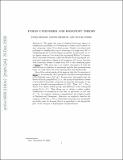| dc.contributor.author | Etingof, Pavel I. | |
| dc.contributor.author | Nikshych, Dmitri | |
| dc.contributor.author | Ostrik, Viktor | |
| dc.date.accessioned | 2011-05-25T21:00:47Z | |
| dc.date.available | 2011-05-25T21:00:47Z | |
| dc.date.issued | 2010-01 | |
| dc.date.submitted | 2009-12 | |
| dc.identifier.issn | 1664-073X | |
| dc.identifier.uri | http://hdl.handle.net/1721.1/63124 | |
| dc.description.abstract | We apply the yoga of classical homotopy theory to classification problems of G-extensions of fusion and braided fusion categories, where G is a finite group. Namely, we reduce such problems to classification (up to homotopy) of maps from BG to classifying spaces of certain higher groupoids. In particular, to every fusion category C we attach the 3-groupoid BrPic(C) of invertible C-bimodule categories, called the Brauer–Picard groupoid of C, such that equivalence classes of G-extensions of C are in bijection with homotopy classes of maps from BG to the classifying space of BrPic(C). This gives rise to an explicit description of both the obstructions to existence of extensions and the data parametrizing them; we work these out both topologically and algebraically.
One of the central results of the article is that the 2-truncation of BrPic(C) is canonically equivalent to the 2-groupoid of braided auto-equivalences of the Drinfeld center Z(C) of C. In particular, this implies that the Brauer–Picard group BrPic(C) (i.e., the group of equivalence classes of invertible C-bimodule categories) is naturally isomorphic to the group of braided auto-equivalences of Z(C). Thus, if C = VecA, where A is a finite abelian group, then BrPic(C) is the orthogonal group O(A ⊕ A*). This allows one to obtain a rather explicit classification of extensions in this case; in particular, in the case G = ℤ2, we re-derive (without computations) the classical result of Tambara and Yamagami. Moreover, we explicitly describe the category of all (VecA1,VecA2)-bimodule categories (not necessarily invertible ones) by showing that it is equivalent to the hyperbolic part of the category of Lagrangian correspondences. | en_US |
| dc.language.iso | en_US | |
| dc.publisher | European Mathematical Society | en_US |
| dc.relation.isversionof | http://dx.doi.org/10.4171/QT/6 | en_US |
| dc.rights | Creative Commons Attribution-Noncommercial-Share Alike 3.0 | en_US |
| dc.rights.uri | http://creativecommons.org/licenses/by-nc-sa/3.0/ | en_US |
| dc.source | Prof. Etingof via Michael Noga (arXiv ms.) | en_US |
| dc.title | Fusion Categories and Homotopy Theory | en_US |
| dc.type | Article | en_US |
| dc.identifier.citation | Etingof, Pavel, Dmitri Nikshych and Viktor Ostrik. "Fusion Categories and Homotopy Theory." Quantum Topology, 1.3, 2010, pp. 209–273 | en_US |
| dc.contributor.department | Massachusetts Institute of Technology. Department of Mathematics | en_US |
| dc.contributor.approver | Etingof, Pavel I. | |
| dc.contributor.mitauthor | Etingof, Pavel I. | |
| dc.relation.journal | Quantum Topology | en_US |
| dc.eprint.version | Author's final manuscript | en_US |
| dc.type.uri | http://purl.org/eprint/type/JournalArticle | en_US |
| eprint.status | http://purl.org/eprint/status/PeerReviewed | en_US |
| dspace.orderedauthors | Etingof, Pavel; Nikshych, Dmitri; Ostrik, Viktor | en |
| dc.identifier.orcid | https://orcid.org/0000-0002-0710-1416 | |
| mit.license | OPEN_ACCESS_POLICY | en_US |
| mit.metadata.status | Complete | |
